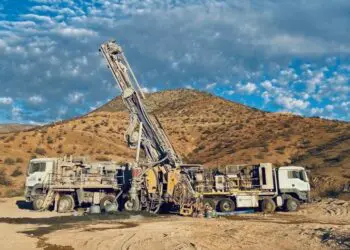The West Australian | Helen Barling | 28 June 2023

Hot Chili’s drill rig at its picturesque Cortadera project on Chile’s copper coastline. Credit: File
Hot Chili says its Costa Fuego project in Chile will spit out a whopping AU$309 million a year on average in free cash across a 16-year mine life.
With an impressive set of numbers outlined in a freshly-minted preliminary economic assessment (PEA), the project is emerging as one of the world’s biggest and lowest-cost copper plays, with an estimated post-tax net present value (NPV) of US$1.1 billion (AU$1.66 billion).
And in a heavy-hitting endorsement for the operation, leading US royalty streaming group Osisko Gold Royalties has tipped US$15 million (AU$22.4 million) into Hot Chili’s till.That up-front investment for down-the-track royalty payments is destined to fast-track the company’s ongoing prefeasibility study and will also be used to fund resource growth drilling.
Hot Chili managing director Christian Easterday says Osiko’s involvement, alongside mining giant Glencore’s strategic lead shareholding in the company, demonstrates Costa Fuego’s global relevance and the project’s potential to deliver a near-term, meaningful, new copper supply.
Osisko’s funding comes in exchange for a 1 per cent net smelter return (NSR) royalty on copper and a 3 per cent NSR on gold from across the Costa Fuego copper-gold project, which sits in the low coastal range of the Atacama Region, 600km north of the Chilean capital of Santiago.
Despite the eye-opening US$1.05 billion (AU$1.57 billion) Hot Chili says it will cost to build its project, it says its payback period will be just three and a half years. Average annual operating costs have clocked in at US$1.33 (AU$2) per pound of copper in the study, positioning the company at the low end of the cost curve among its industry peers.
Keys to the lower-cost estimates include the fact that at its relatively low altitude, it does not face the extraordinary costs of having to pump water up into the mountains, in addition to the fact it has proven better recoveries using salt water and does not need an expensive desalination plant. It is believed those factors alone save the company about US$1 billion (AU$1.51 billion).
The economic evaluation pegged a long-term average selling price at US$3.85 (AU$5.76) per pound of copper and US$1750 (AU$2620) per ounce of gold. But the company says that for every extra 10 cents added to that copper selling estimate – and at a time when global predictions of a significant price hike are growing by the day – it will add another US$100 million (AU$150.1 million) to its post-tax NPV.
An pre-tax internal rate of return of 24 per cent and a pre-tax NPV of US$1.54 billion (A$2.30 billion) are also predicted in the study.
Costa Fuego holds 725 million tonnes of measured and indicated resources grading 0.47 per cent copper equivalent for 2.8 million tonnes of copper and 2.6 million ounces of gold with molybdenum credits.
A PEA study is similar in nature to an Australian JORC scoping study. Hot Chili believes its cursory assessment at its Costa Fuego project suggests it could churn out about 112,000 tonnes of copper equivalent each year for the first 14 years of an initial 16-year mine life.
Hot Chili is now one of a select group of companies with a copper development project of this scale of production that is not controlled by a major. The Company is also advantaged by its coastal, low elevation location and abundant existing infrastructure, reducing its economic hurdle and resulting in one of the lowest capital intensity of its global peer projects.
Hot Chili chairman Nicole Adshead-Bell
While copper prices have softened in recent months from this year’s high of US$4.27 (AU$6.39) per pound, demand for the red metal is set to skyrocket.
Billionaire copper juggernaut Robert Friedland, of Ivanhoe Electric, recently weighed in on the looming copper “train wreck”, predicting prices could increase tenfold amid expected global shortages.
Mr Friedland, who has been instrumental behind major copper discoveries in Mongolia and the Congo, believes the metal’s longer-term prospects will be supported by decarbonisation, ongoing Chinese demand, the emergence of India as a significant industry player and re-militarisation in the wake of Russia’s invasion of Ukraine.
Copper is yet to find a place on the critical metals lists of most developing nations. However, the metal is crucial in the global push towards net-zero carbon emissions due to its thermo-conductivity properties. The European Union recently proposed that both copper and battery-grade nickel be classified as critical raw materials key to the energy transition in a move designed to bolster its supplies.
Meanwhile, Hot Chili is warming up the drill rigs to start a 30,000m drilling blitz to target resource extensions, in addition to exploring additional priority prospects designed to feed into a resource upgrade later this year. The company has also completed the lion’s share of a prefeasibility study, which is due to be released next year.
Importantly, it still has only 119 million shares on issue, giving it a genuine opportunity to raise equity without blowing up its capital structure.
Timing, as the saying goes, is everything. With copper prices yet to reflect the dangerously low shortages of the critical metal, Hot Chili looks poised to develop its low-cost Costa Fuego project at precisely the right time.
It has been some ride for the company since it listed in 2010. It survived when the copper industry was largely decimated by a price downturn to build up to a billion-tonne resource after adding the Cortadera project to its original Productora play.
And while its project on an established Chilean copper coastline might sit in the shadows of the towering Andes mountain range, it appears to now be well on the way to putting other ASX-listed copper hunters in the shade.
